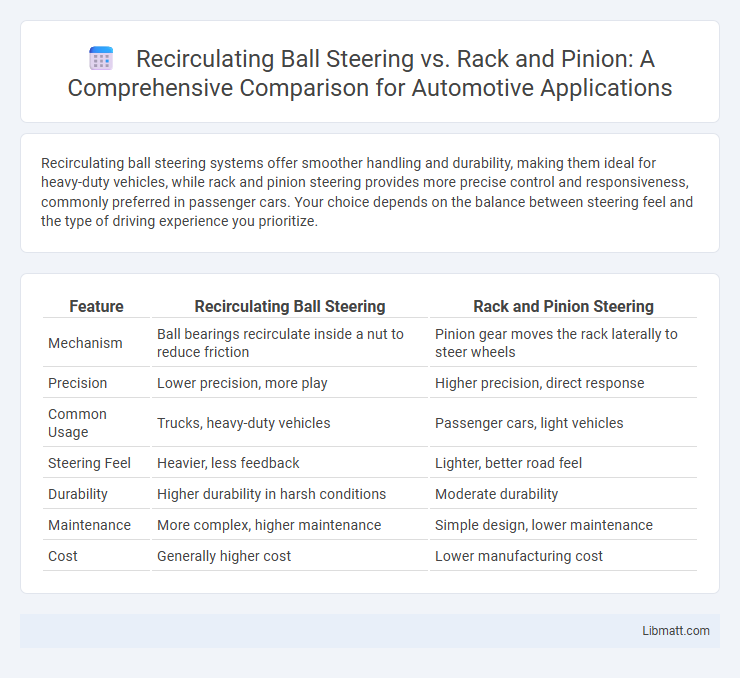Recirculating ball steering systems offer smoother handling and durability, making them ideal for heavy-duty vehicles, while rack and pinion steering provides more precise control and responsiveness, commonly preferred in passenger cars. Your choice depends on the balance between steering feel and the type of driving experience you prioritize.
Table of Comparison
| Feature | Recirculating Ball Steering | Rack and Pinion Steering |
|---|---|---|
| Mechanism | Ball bearings recirculate inside a nut to reduce friction | Pinion gear moves the rack laterally to steer wheels |
| Precision | Lower precision, more play | Higher precision, direct response |
| Common Usage | Trucks, heavy-duty vehicles | Passenger cars, light vehicles |
| Steering Feel | Heavier, less feedback | Lighter, better road feel |
| Durability | Higher durability in harsh conditions | Moderate durability |
| Maintenance | More complex, higher maintenance | Simple design, lower maintenance |
| Cost | Generally higher cost | Lower manufacturing cost |
Introduction to Automotive Steering Systems
Recirculating ball steering systems use a series of ball bearings to reduce friction and provide smoother steering, especially in larger vehicles and trucks. Rack and pinion steering offers a more direct and responsive feel, commonly found in passenger cars due to its simplicity and precision. Your choice between these systems impacts vehicle handling, steering effort, and overall driving comfort.
Overview of Recirculating Ball Steering
Recirculating ball steering utilizes a series of ball bearings that roll between the steering gear and the steering shaft, reducing friction and wear while providing smooth steering performance. This system is commonly found in heavier vehicles and trucks due to its durability and ability to handle high steering loads effectively. Your vehicle's steering responsiveness and feedback may differ compared to rack and pinion systems, with recirculating ball offering a more robust and reliable solution for heavy-duty applications.
Fundamentals of Rack and Pinion Steering
Rack and pinion steering converts rotational motion from the steering wheel into linear motion to turn the vehicle's wheels, using a gearset consisting of a circular pinion gear and a flat, toothed rack. This system provides precise, direct steering feedback and is lighter and more compact than recirculating ball setups, making it ideal for passenger cars. Your vehicle's handling and responsiveness benefit significantly from the efficient mechanical simplicity inherent in rack and pinion steering.
Key Differences Between Recirculating Ball and Rack and Pinion
Recirculating ball steering systems use a series of ball bearings to reduce friction and wear between the steering shaft and the gear, providing smoother operation in heavy-duty vehicles. Rack and pinion steering converts the rotational motion of the steering wheel directly into linear motion, offering more precise control and responsiveness in lighter passenger cars. Your choice between these systems depends on vehicle type, with recirculating ball preferred for trucks and SUVs and rack and pinion favored for performance and passenger vehicles.
Performance and Handling Comparison
Recirculating ball steering offers durability and smooth operation in heavy-duty vehicles but tends to provide less precise feedback and slower response compared to rack and pinion systems. Rack and pinion steering delivers sharper handling, improved steering accuracy, and quicker turn-in response, enhancing performance in passenger cars and sports vehicles. The direct mechanical linkage of rack and pinion enables better road feel and control, making it preferred for performance-oriented driving.
Maintenance and Durability Factors
Recirculating ball steering systems require less frequent maintenance due to their robust design, making them ideal for heavy-duty vehicles where durability is critical. Rack and pinion steering offers more precise control and lighter weight but may demand more regular upkeep, especially in high-performance or off-road conditions. You should consider the balance between maintenance intervals and long-term durability when choosing between these two steering mechanisms for your vehicle.
Typical Applications in Modern Vehicles
Recirculating ball steering systems are commonly found in heavy-duty trucks, SUVs, and off-road vehicles due to their durability and ability to handle high torque loads. Rack and pinion steering dominates in passenger cars and light trucks, offering precise steering control and a more compact design ideal for modern vehicle engineering. Automotive manufacturers select steering types based on vehicle size, performance needs, and intended usage scenarios to optimize handling and driver experience.
Advantages of Recirculating Ball Steering
Recirculating ball steering offers superior durability and reduced friction compared to rack and pinion systems, making it ideal for heavy-duty vehicles and trucks. Its design allows for smoother steering with less wear over time, enhancing vehicle control in rough terrain or demanding driving conditions. The system's robustness translates to lower maintenance requirements and increased longevity, especially under high-stress usage.
Benefits of Rack and Pinion Steering
Rack and pinion steering offers precise and responsive handling, making it ideal for performance-oriented vehicles and everyday driving. Its simpler design reduces weight and maintenance costs compared to recirculating ball steering, enhancing overall vehicle efficiency. You benefit from improved steering feedback and quicker turn response, resulting in a more controlled and enjoyable driving experience.
Choosing the Right Steering System for Your Needs
Recirculating ball steering offers durability and smooth operation, making it ideal for heavy-duty vehicles and off-road applications, while rack and pinion steering provides precise handling and a more direct feel, preferred for sports cars and everyday passenger vehicles. Your choice depends on driving conditions, vehicle type, and maintenance preferences, balancing durability with responsiveness. Consider your driving style and vehicle requirements to select the steering system that enhances control and comfort.
Recirculating Ball Steering vs Rack and Pinion Infographic

 libmatt.com
libmatt.com